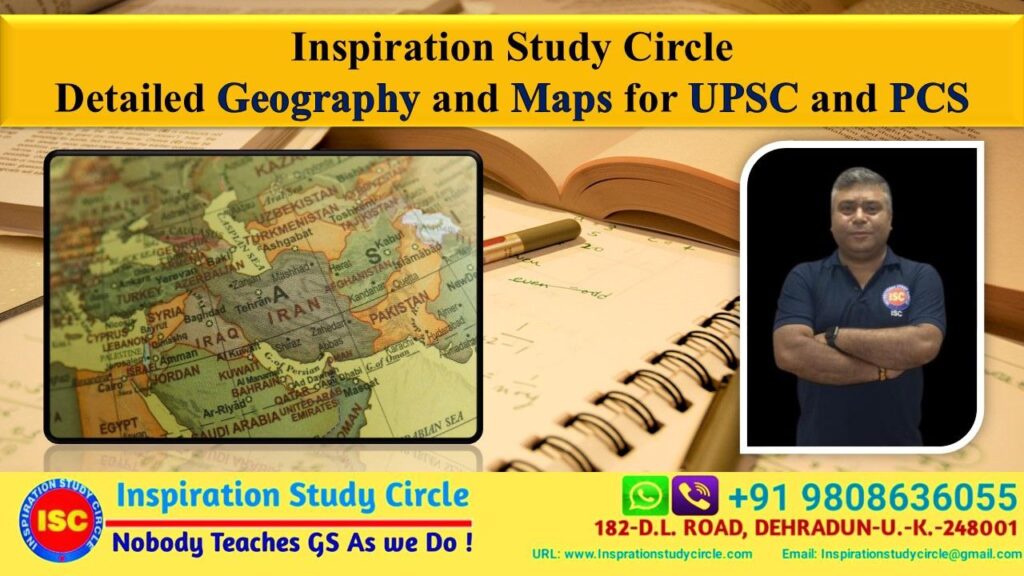Detailed Geography and Maps for UPSC and PCS
Table of Contents
Inspiration Study Circle Detailed Geography and Maps for UPSC and PCS

Preparing and studying for UPSC CSE is one back-breaking task that requires an ultimate level of commitment and precision. The Civil Service Exam needs you to be a generalist in everything that goes on around the nation and the world. Every year, UPSC outlines various questions from various fields and topics. However, the overall syllabus and consistency remain the same. The set of Map-Based Questions is one such category.
The most common question asked by both freshers and veterans concerning preparation for the UPSC CSE is, “How to prepare Map-Based questions?”
Inspiration Study Circle, Dehradun, brings to you a study plan/pattern to help you excel in questions based on Maps.
Map-Based Topics and Current Affairs by ISC
Inspiration Study Circle brings to you a detailed study on maps and key points on the Geography of India and the World, easily available on our website, accompanied by daily current affairs.
Unlock the Power of Geography: Explore In-Depth Map Details on Our Website
Dive into the world of geography with our comprehensive collection of map details, available exclusively on our website. Our PDF guide provides an in-depth look at geographical features, boundaries, and spatial relationships, helping you gain a deeper understanding of our world’s complex landscape. Whether you’re a fresher, beginner, or UPSC aspirant with Geography as an optional subject, our map details will prove invaluable for your studies, projects, or explorations. With our detailed maps, you’ll be able to visualize and analyze geographical data, identify patterns, and make informed decisions. Our PDF guide is a valuable resource that will enhance your knowledge of geography and help you stay up-to-date with the latest geographical information. Download our PDF today and start exploring the fascinating world of geography.
To access more geographical information and updates, visit our website’s Current Affairs section, where we regularly post new content daily. Our Current Affairs section is available in both English and Hindi, catering to a wide range of audiences. You can find us at https://inspirationstudycircle.com/ and navigate to the Current Affairs section to stay informed about the latest geographical developments and more.
Boost Your UPSC 2026, UPPCS 2025, and UKPCS 2026 Prep with Our Geography Map Details
Are you preparing for the UPSC or PCS exams? Our comprehensive collection of geography map details can be a valuable resource for your preparation.
– Static Geography Knowledge: Our map details cover geographical features, boundaries, and spatial relationships, which are essential for the static portion of the geography syllabus.
– Current Affairs: By staying updated with the latest geographical developments through our Current Affairs section, you’ll be well-prepared to tackle questions related to environmental issues, natural disasters, and government policies.
– Map-Based Questions: Our detailed maps will help you visualize and analyze geographical data, making it easier to answer map-based questions in the exam.
– Interdisciplinary Approach: Geography overlaps with other subjects like history, economics, and polity. Our map details will help you understand these connections and make your preparation more comprehensive.
By utilizing our geography map details and Current Affairs section, you’ll be better equipped to:
– Enhance your understanding of geographical concepts and phenomena
– Analyze and interpret geographical data
– Answer map-based questions with confidence
– Stay updated with the latest geographical developments and issues
Make the most of our resources and boost your chances of success in the UPSC 2026 and PCS exams. Visit our website’s Current Affairs section daily for updates in both English and Hindi.
Begin with Learning about India first!
What is more important than knowing your country first? The best way is to start with the Geography and Maps of India. Move from political to physical maps.
States, Union Territories, and their Capitals
- Begin by knowing the States, Union Territories, and their Capitals on a political map of India.
- Garner for States with maximum and minimum area and population.
- Learn the neighbors of all states, and which boundaries they share.
- The most and least number of states that share their boundaries.
- Mark and learn the positions of different Union Territories and their capitals, and which states share their boundaries.
- Candidates must know how to draw a political map (outline) of India by hand (very important for Main’s paper GS I and GS II).
- You should be able to identify East/West/North/South areas of states and union territories. Whenever a new state is created from the existing territory of India, the subsequent changes in state boundaries must be noted.
International Borders of India and its neighbours
- Learn about the country’s neighbors.
- The states that share the boundary lines with neighboring countries.
- Give comparatively more importance to the countries within the Indian subcontinent.
- Note down the states that have coastal borders and those that have territorial borders.
- Differentiate within the states that have different water bodies at their coastline, i.e., the Arabian Sea, the Bay of Bengal, and the Indian Ocean.
- Make points on the Islands of India and the water body they reside in.
Latitudes and Longitudes
- Make a note of the latitudes and longitudes that cross India.
- Learn about the different states, capitals, and rivers that each major Geographical line crosses. Example: the names of the states that are crossed by the Tropic of Cancer.
- Study the ‘concept-based’ lines, nature of beaches, etc. For example, the Division of India, based on a 20°C isotherm.
Water Bodies and Hydro Projects
- Study the major rivers, their tributaries, and sub-tributaries, along with which States and major cities they cross.
- Look for lakes and canals that are known for their Heritage and cultural significance, any unique features, or have been in the news recently.
- Names and locations of major dams and hydro projects, along with their district and state. Make sure you can mark them on a physical map of India.
Mountains, Natural Vegetation, and Glaciers
- Note the extent of all mountain ranges and important peaks. A candidate should be able to mark the whole mountain ranges on a political map of India with their highest peaks.
- Study the various passes/passes, national parks, flora, fauna, states, etc., in the geographical distribution of such mountain ranges.
- State the spatial distribution of forest types and vegetation in India.
- Note and learn all the important National Parks, Tiger Reserves, Wildlife Reserves, Biosphere Reserves, etc., and see their extent across the state.
Other Important Features and Places
- Make note of all the cities, places, and events that have been in the news throughout the year, along with the physical and geographical features.
- Identify all the important places of India, including pilgrimage sites, world heritage sites, nuclear power stations, ports, plateaus, wetlands, mineral-rich places, etc., and other important physical features nearby.
The World Map
Continents and Oceans
- Make a note of all the continents, oceans, seas, and the countries they contain or make borders with.
- You should be able to know the international borders and whether they are landlocked or not.
- Especially the water bodies and countries, with capitals that have been in the news.
Physical and Relief Features
- Major locations of interest in the news, their location, and their order on the map.
- Major physical features and the regions they are located in.
- Major international projects and the countries they involve.
- Note down all the important physical features you come across in standard Geography/History/Economics books.
Lines: Latitudes and Longitudes
- Learn the important latitudes and longitudes on the world map (such as the Tropic of Cancer, Tropic of Loom, Arctic Circle, and Equator). Note the country each line crosses.
- Study the International Date Line, Prime Meridian, and which countries fall on which side.
Stay Updated, Practice, and Revise!
- When you come across a major location in the news, immediately look it up on a map (or the Internet) to see its location.
- Note if the location of the region is geopolitically important, especially the Middle East and Central/South Asia regions.
- Solve map-based questions asked in the last 10 years and note the questions asked. Focus on those areas when studying the map.
- Mind maps of India and the world will make the most of the study of current affairs, geography, world history, economy, etc., very intuitive and help a lot in understanding.
Recent Post

The Viksit Bharat – Guarantee for Rozgar and Ajeevika Mission (Gramin) Bill, 2025
The Viksit Bharat – Guarantee for Rozgar and Ajeevika Mission (Gramin) Bill, 2025 Table of Contents The Viksit Bharat – Guarantee

How to Prepare for UKPCS 2026 in Six Months
How to Prepare for UKPCS 2026 in Six Months Table of Contents ISC- How to Prepare for UKPCS 2026 in

UKPSC Upper and Lower PCS Combined Batch for 2026- 2027
UKPSC Upper and Lower PCS Combined Batch for 2026-2027 Table of Contents Unlocking Uttarakhand’s Civil Services: The Power of UKPCS

Explained: Russian President Vladimir Putin’s State Visit to India
Explained: Russian President Vladimir Putin’s State Visit to India Table of Contents Russian President Vladimir Putin conducted a state visit

UPPSC Upper PCS 2025: Mains Test Series and Answer Writing
UPPSC Upper PCS 2025: Mains Test Series and Answer Writing Table of Contents Inspiration Study Circle- Dehradun The UPPSC PCS

Explained: The Sanchar Saathi App
The Sanchar Saathi App Table of Contents The Sanchar Saathi app is a security and user-protection platform developed by India’s Department of Telecommunications (DoT) to help users manage mobile connections, report fraud, and locate lost phones
